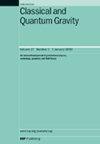A cryogenic test-mass suspension with flexures operating in compression for third-generation gravitational-wave detectors
IF 3.7
3区 物理与天体物理
Q2 ASTRONOMY & ASTROPHYSICS
引用次数: 0
Abstract
This paper presents an analysis of the conceptual design of a novel silicon suspension for the cryogenic test-mass mirrors of the low-frequency detector of the Einstein telescope gravitational-wave observatory. In traditional suspensions, tensional stress is a severe limitation for achieving low thermal noise, safer mechanical margins and high thermal conductance simultaneously. In order to keep the tensional stress sufficiently low, we propose the use of rigid beams with large cross sections, combined with short flexures under compressional load. This configuration takes advantage of the higher strength of silicon in compression with respect to its strength in tension. The flexures are mechanically robust and at the same time soft in the working direction, thus producing low suspension thermal noise and, by being short, provide high thermal conductance for cryogenic cooling. The rigid beams, located between the test mass and an intermediate mass, allow the elimination of the recoil mass used conventionally for applying control forces for interferometer lock, and the use of optical anti-springs to reduce the pendulum resonant frequency to further improve the vibration isolation of the test mass. The configuration has the capability to reach a lower mirror operational temperature, which is expected to produce a substantial reduction of the thermal noise in the mirrors of the interferometer.用于第三代引力波探测器的具有弯曲的低温测试质量悬架
本文分析了用于爱因斯坦望远镜引力波天文台低频探测器低温试验质量镜的新型硅悬架的概念设计。在传统的悬架中,拉应力是同时实现低热噪声、更安全的机械裕度和高导热性的严重限制。为了保持足够低的拉应力,我们建议使用大截面的刚性梁,在压缩荷载下结合短挠曲。这种结构利用了硅的压缩强度相对于其拉伸强度较高的优点。挠曲在机械上坚固,同时在工作方向上柔软,因此产生低悬浮热噪声,并且由于短,为低温冷却提供高导热性。刚性梁位于测试质量和中间质量之间,可以消除常规用于施加干涉仪锁定控制力的后坐力,并使用光学防弹簧来降低摆共振频率,以进一步提高测试质量的隔振性。该配置能够达到较低的反射镜工作温度,这有望大大降低干涉仪反射镜中的热噪声。
本文章由计算机程序翻译,如有差异,请以英文原文为准。
求助全文
约1分钟内获得全文
求助全文
来源期刊

Classical and Quantum Gravity
物理-天文与天体物理
CiteScore
7.00
自引率
8.60%
发文量
301
审稿时长
2-4 weeks
期刊介绍:
Classical and Quantum Gravity is an established journal for physicists, mathematicians and cosmologists in the fields of gravitation and the theory of spacetime. The journal is now the acknowledged world leader in classical relativity and all areas of quantum gravity.
 求助内容:
求助内容: 应助结果提醒方式:
应助结果提醒方式:


